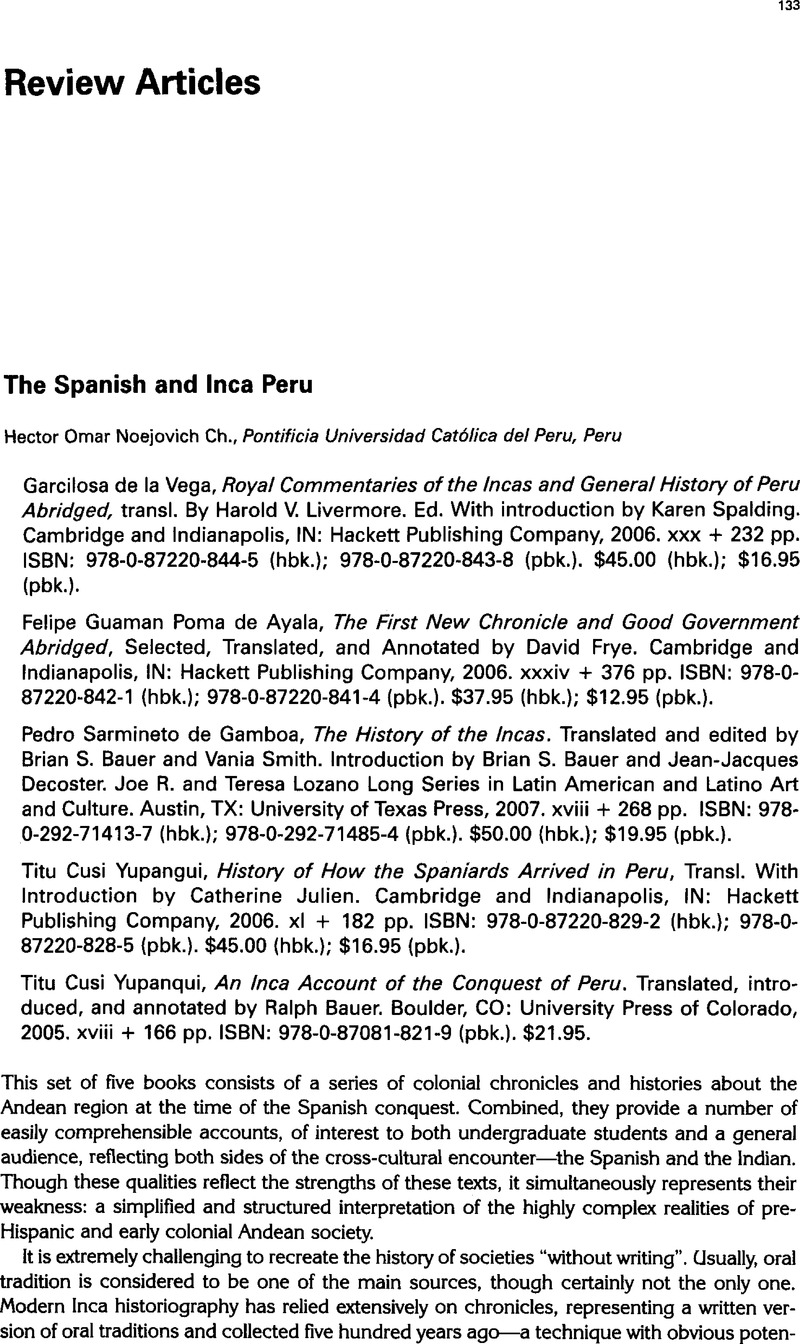No CrossRef data available.
Published online by Cambridge University Press: 11 January 2010

1 Livermore, Harold V., trans., Royal Commentaries of the Incas and General History of Peru. 2 vols. Austin, TX: University Texas Press, 1966.Google Scholar
2 See Raul Porras Barrenechea, Los Cronistas del Perú (1528–1650). Lima: Banco de Crédito del Perú, 1986. According to Barrenechea, Qarcilaso had a “unilateral vision”, 400.
3 Felipe Guaman Poma de Ayala, Primer Nueva Corónica y Buen Gobiemo. Critical edition by John V. Murra and Rolena Adorno. Translations and textual analysis from quechua by Jorge L. Urioste. México: Siglo XXI, 1980.
4 See Castillo, Guillermo Céspedes dela, “La Visita Como Institución Indiana”, Anuario de Estudios Americanos 3 (1946): 984–1025Google Scholar; and Bella, Ismael Sanchez, Derecho Indiano. Estudios. Las Visitas Generates en la América Española (Siglos XVI–XVII). Pamplona: University of Navarra, 1991.Google Scholar
5 See Hanke, Lewis and Rodríguez, Celso, Los Virreyes Españoles en América Durante el Gobierno de la Casa de Austria. Perú I. Madrid: Biblioteca de Autores Españoles CLLXXX, 1978.Google Scholar
6 Markham, Clements R., ed., History of the Incas and the Execution of Tupac Amaru. Works issued by the Hakluyt Society, 2nd series, no. 22. Cambridge: Hakluyt Society, 1907.Google Scholar
7 Among others see Pease, Franklin, “La Noción de Propiedad entre Los Incas: Una Aproximación”, in Masuda, Sosho, ed., Etnografia e Historia del Mundo Andino: Continuidad y Cambio. Tokyo: University of Tokio, 1986Google Scholar; Ramírez, Susan E., The World Turned Upside Down: Cross-Cultural Contact and Conflict in Sixteenth-Century Peru. Stanford: Stanford University Press, 1996.Google Scholar
8 Beatriz Coya Inca, Sayri Tupac's daughter, who had been promised in marriage to Titu Cusi's son, Felipe Quispe Tito. Finally, Beatriz Coya Inca was married to Martin Garcia de Loyola. Sayri Tupac was Titu Cusi's predecessor as ruler of Vilcabamba.
9 Villena, Guillermo Lohmann, “El Inca Titu Cusi Yupanqui y su Entrevista con el Oidor Matienz 1565”, Mercurio Peruano, 23:167 (1941): 3–18.Google Scholar
10 Franklin Pease G.Y., Las Crónicas y Los Andes. México: Fondo de Cultura Económica, 1995.Google Scholar
11 Gareis, Inés. “El Efecto Rashomon en Fuentes Etnohistóricas”, América Indígena 54:4 (1994): 141–56.Google Scholar